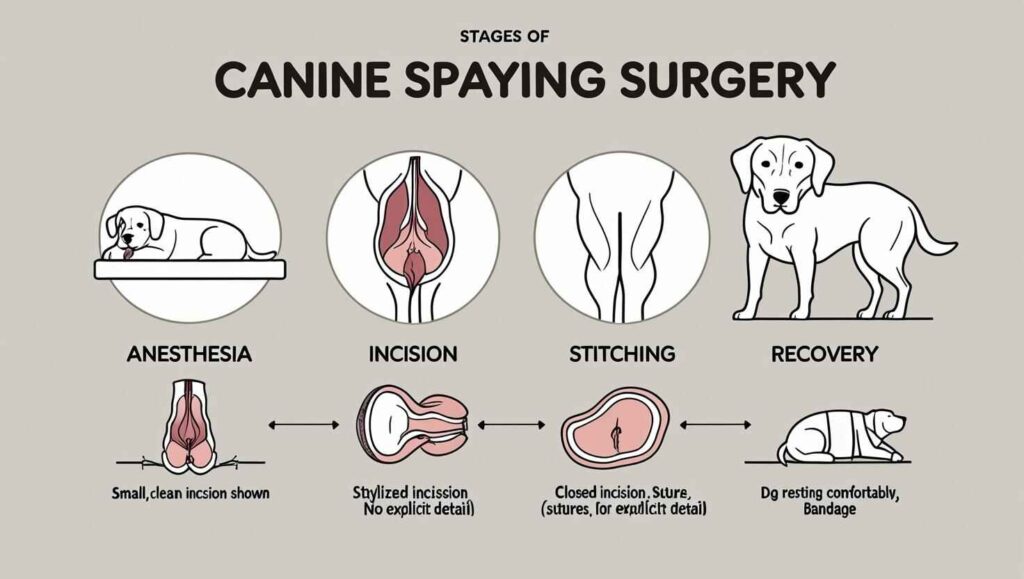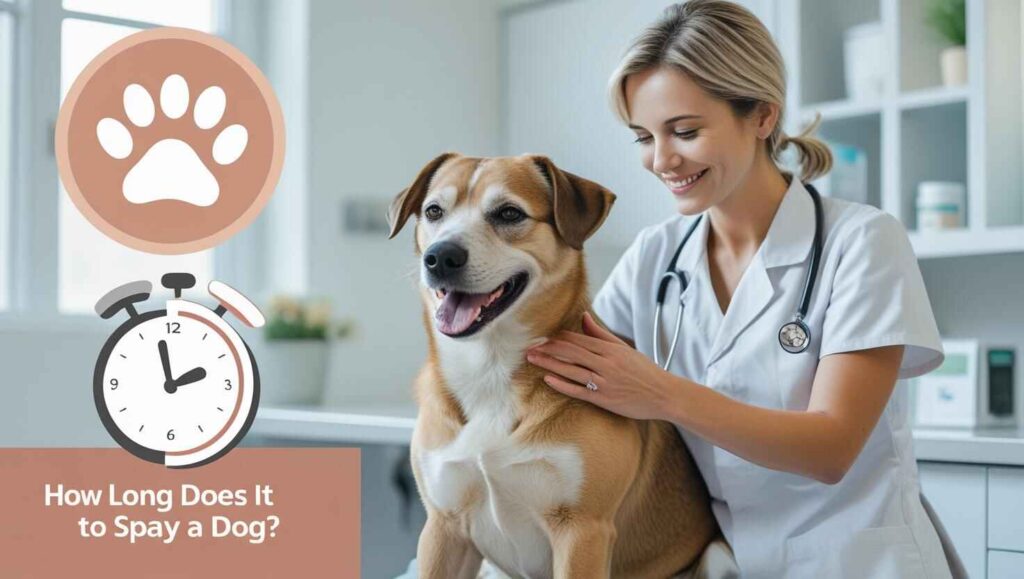🐾 What Does Spaying a Dog Involve?
Spaying is the surgical removal of a female dog’s reproductive organs—typically the ovaries and uterus. This procedure prevents the dog from becoming pregnant and offers several behavioral and health benefits.
It’s often performed by a licensed veterinarian and is considered a routine yet significant surgery for pet health management.
⏱️ How Long Does It Take to Spay a Dog?
The actual spaying surgery takes approximately 20 to 90 minutes, depending on several factors such as the dog’s age, size, breed, and overall health.
Here’s a quick breakdown:
| Dog Type | Estimated Surgery Time |
|---|---|
| Puppy (Under 6 months) | 20–30 minutes |
| Adult Dog | 45–60 minutes |
| Overweight/Older Dog | Up to 90 minutes |
| Complications Present | May exceed 90 minutes |
While the surgery itself may be brief, your dog will stay at the clinic for 4–6 hours total, which includes:
- Pre-surgery prep
- Anesthesia induction
- Post-op monitoring

🔍 Factors That Affect Surgery Duration
Several elements influence how long it takes to spay a dog:
🐶 1. Age of the Dog
Younger dogs typically require less time as their tissues are easier to work with and they usually heal faster.
⚖️ 2. Weight and Body Condition
Heavier or overweight dogs might require more time due to increased fat layers and anesthesia management.
🩺 3. Reproductive Status
If your dog is in heat or has had puppies, the uterus may be enlarged and require more effort to remove safely.
⚕️ 4. Surgeon Experience
Veterinarians with more surgical experience generally perform the procedure more efficiently.
🧼 What Happens Before the Procedure?
Before your dog is spayed, the vet will:
- Conduct a physical examination
- Possibly perform bloodwork
- Ask you to withhold food 8–12 hours prior
- Explain the risks and aftercare steps
Sedatives and anesthesia are administered just before surgery begins.
🩻 The Spaying Process: Step-by-Step

Here’s what happens during a typical spaying procedure:
- Anesthesia: Your dog is placed under general anesthesia.
- Shaving & Disinfecting: The abdominal area is shaved and sterilized.
- Incision: The vet makes a tiny cut in the belly area to begin the procedure
- Organ Removal: The vet carefully takes out the ovaries—and in some cases, the uterus too—as part of the procedure
- Stitching: The incision is closed with dissolvable or external stitches.
- Recovery: Your dog is monitored until she wakes up safely.
🛌 Immediate Post-Surgery Care
After the surgery, dogs are kept for a few hours for observation. At home, ensure:
- A quiet resting space
- Minimal physical activity
- No licking or biting at stitches
- Regular medication (if prescribed)
Most dogs can return to normal behavior in 2–3 days.

🗓️ Full Recovery Timeline
| Time After Surgery | What to Expect |
|---|---|
| 24–48 Hours | Sleepiness, mild swelling |
| Day 3–5 | Increased energy, appetite returns |
| Day 7–10 | Stitches check or removal (if needed) |
| Day 14 | Fully healed in most cases |
Recovery varies per dog but typically takes 10–14 days for full healing.
✅ Pros of Spaying Your Dog
- Prevents unwanted pregnancies
- Reduces risk of uterine infections (pyometra)
- Lowers chances of mammary tumors
- Prevents messy heat cycles
- Can reduce roaming and aggression behaviors
⚠️ Cons and Risks of Spaying
While spaying is generally safe, there are potential downsides:
- Risk of surgical complications (bleeding, infection)
- Possible weight gain if not managed
- Slight risk of urinary incontinence
- General anesthesia carries risks, especially for older dogs
Always consult your vet to evaluate the risks specific to your dog.
📅 Ideal Age to Spay Your Dog
The best age to spay is typically between 4–6 months, but this may vary based on breed:
- Small breeds: Often spayed around 4–6 months
- Large breeds: May benefit from waiting until 12–18 months
Some evidence suggests early spaying in large dogs can affect joint development.
🐕 Spaying Large Dogs vs. Small Dogs
- Large Dogs: Require more anesthesia, larger incision, longer healing
- Small Dogs: Smaller dogs tend to bounce back quicker and usually spend less time under surgery
Breed-specific risks should be discussed with your vet.
🔬 Laparoscopic vs. Traditional Spaying
Laparoscopic (keyhole) spaying is less invasive and offers quicker recovery. However, it’s:
- More expensive
- Not available at all clinics
Traditional spaying remains more common and is equally effective when performed correctly.
💸 Cost Breakdown of Spaying
| Item | Estimated Cost (USD) |
|---|---|
| Standard Spay | $50–$300 |
| Laparoscopic Spay | $400–$1,000 |
| Blood Tests | $50–$100 |
| Medications | $20–$50 |
Low-cost clinics or local shelters may offer discounted procedures.
📦 How to Prepare Your Dog for Surgery
- Fast your dog the night before
- Walk them early in the morning
- Bring comfort items (like a blanket or toy)
- Ask your vet any last-minute questions
👀 What to Watch for After Surgery
Call your vet if you notice:
- Excessive swelling or redness
- Bleeding from the incision
- Vomiting or diarrhea
- Loss of appetite after 24 hours
- Lethargy that lasts more than 48 hours
Early intervention can prevent complications.
🔗 External Resource: American Veterinary Medical Association on Spaying/Neutering
❓ Frequently Asked Questions
1. Can a dog be spayed while in heat?
Yes, but it’s more complicated and may take longer due to increased blood flow and larger uterus size.
2. Is spaying painful for dogs?
Dogs are under anesthesia during the procedure. Pain management meds are provided post-surgery to ensure comfort.
3. How do I keep my dog from licking her stitches?
To keep your dog from licking or scratching the incision, try using a cone (Elizabethan collar) or a comfy recovery suit.
4. Will my dog gain weight after spaying?
Possibly, but it can be managed with a healthy diet and regular exercise.
5. How soon can my dog bathe after spaying?
Wait at least 10–14 days or until the incision is fully healed.
6. Is spaying reversible?
No. Spaying is permanent and should be done only when you’re certain.
🐾 Conclusion: Making the Best Choice
Spaying your dog doesn’t take long, but the health and behavior benefits last a lifetime. While the actual surgery may only take under an hour, the decision is long-lasting. Make sure you:
- Understand the recovery process
- Know the risks and benefits
- Choose a qualified veterinarian
- Follow all aftercare instructions
By doing so, you’re ensuring a healthier, happier life for your furry friend.
# :You may also like:



